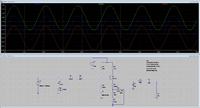mixmaestromark
Newbie level 6
Hi
I have simulated the attached emitter follower circuit in LTspice. Since the transistor is biased from a single postive supply, I don't understand how the output waveform (Red) can be going negative? Surely the waveform should be clipping when it goes below 0V? Note, the output is taken at R8.

Thanks
I have simulated the attached emitter follower circuit in LTspice. Since the transistor is biased from a single postive supply, I don't understand how the output waveform (Red) can be going negative? Surely the waveform should be clipping when it goes below 0V? Note, the output is taken at R8.

Thanks
